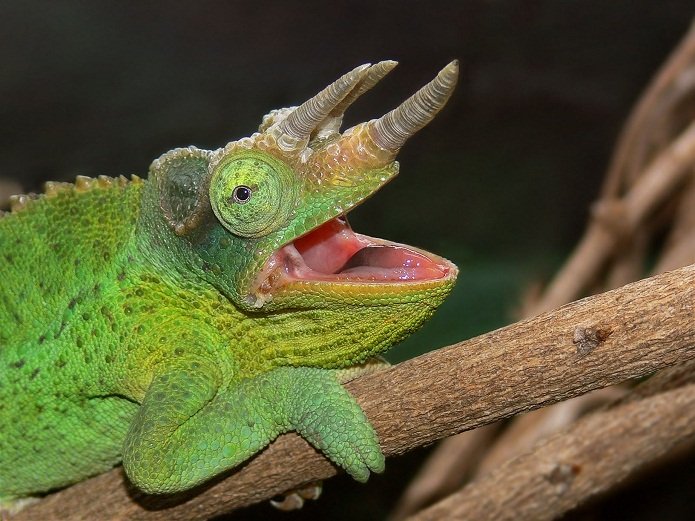
*Jackson’s chameleons* are known for their three distinctive horns and vibrant colors, which can make them seem almost mythical. Found primarily in East Africa, these creatures can display incredible shades of green, blue, and yellow. They have become popular pets due to their interesting looks, but their temperament is not always straightforward. Let’s dive into their behavior to find out more about whether you can expect a gentle companion or a feisty little lizard when you keep a *Jackson’s chameleon*.
Understanding Chameleon Behavior
Chameleons, including the *Jackson’s*, have some pretty unique behavior traits that can affect how they interact with people. When you first bring one home, you might notice that they’re a bit shy. This is normal! Chameleons rely heavily on their environment for safety, so they tend to be more reserved. Think of it as them being introverts that prefer to observe from a distance rather than rush into social situations.
Their primary mode of communication is through color changes. For example, a *Jackson’s chameleon* might turn darker when it feels threatened or stressed. If it’s feeling friendly (or at least not threatened), you might see brighter, more vibrant colors. So, you could say a chameleon’s mood is literally written on its skin! It’s essential to read these signals to understand how your pet is feeling.
Are They Naturally Aggressive?
You might be wondering if *Jackson’s chameleons* are naturally aggressive. The short answer? Not really. These little guys aren’t known for being aggressive toward humans. Instead, their instincts drive them to be cautious. In the wild, they’re prey for birds and other animals, so their instinct is to blend in and avoid confrontation. This means they may react defensively by opening their mouths, hissing, or showing their colors when they feel threatened.
However, there are circumstances that might trigger aggression in a *Jackson’s chameleon*. For instance, if they feel cornered or are placed in an unfamiliar environment, they might lash out as a defense mechanism. Additionally, improper handling or stress from temperature changes can exacerbate their defensiveness. So, while they aren’t aggressive by nature, they certainly can be if they feel scared.
How to Determine Your Chameleon’s Mood
Reading your *Jackson’s chameleon’s* mood is crucial for fostering a friendly relationship. Here’s what to look out for:
- Color Changes: If your chameleon is bright and colorful, it’s likely feeling safe. Darker colors typically indicate stress or fear.
- Body Language: A puffed-up body or an opened mouth can mean your chameleon is trying to appear more intimidating. This is a sign to back off.
- Appetite: A normal appetite indicates a healthy, less stressed chameleon. If it stops eating, something might not be right.
Understanding these signals can help you interact with your pet more effectively. If you see signs of agitation, it might be best to give your chameleon some space until it calms down.
Creating a Friendly Environment
Your *Jackson’s chameleon* will feel more at ease if you create a comfortable environment for it. Here are some tips to help you set up the perfect habitat:
– Temperature Control: Make sure you provide a basking spot of about 85-90°F (29-32°C) while keeping the cooler areas around 75-80°F (24-27°C). Too hot or too cold can stress them out.
– Hiding Spots: Chameleons love to have places to retreat. Include plenty of foliage and branches so they can feel secure and have their own personal space.
– Humidity: Maintain a humidity level of around 50-70%. You can achieve this with a misting system or by using a water dish. Remember, they need to be hydrated to keep their skin healthy and colors vibrant.
By providing a well-structured, safe habitat, you’re promoting a more relaxed chameleon, which could lead to a friendlier demeanor.
Handling Your Jackson’s Chameleon
Now that you know your *Jackson’s chameleon* can have a variety of moods, how do you handle it? Here are some key points to keep in mind:
- Start Slowly: When you first get your chameleon, give it a few weeks to settle in. Avoid handling it too soon. Let it get used to its environment.
- Gentle Touch: When you do start to handle your chameleon, always be gentle. Place your hand in the habitat slowly and allow the chameleon to approach you. It’s all about trust!
- Limit Handling Time: Chameleons aren’t like dogs; they don’t crave interaction. Limit handling to short sessions to avoid unnecessary stress.
By approaching handling with care and gradually building trust, you’ll likely develop a better bond with your *Jackson’s chameleon*.
Common Misconceptions
Many people have misconceptions about *Jackson’s chameleons*. One major myth is that they are always aggressive or unfriendly. This stems from their unique appearance and their defensive behaviors when frightened. But remember, like any animal, their temperament can vary widely from one individual to another.
Another misconception is that they can be handled like a dog or cat. While they can learn to tolerate you, they aren’t inherently social animals and typically don’t enjoy being passed around. They are happiest when left alone to explore their habitat at their own pace.
Understanding these myths can help potential owners make informed decisions about whether a *Jackson’s chameleon* is the right pet for them.
In the end, *Jackson’s chameleons* are not aggressive by nature, but rather cautious creatures that can display defensive behaviors when they feel threatened. By learning how to read their moods, creating a comfortable environment, and handling them with care, you can foster a friendly relationship with your chameleon. Just remember that they thrive on predictability and gentle handling, which can help turn a nervous critter into a relaxed one. Whether you’re nurturing a budding hobby or looking for a unique pet, the *Jackson’s chameleon* can be a rewarding companion if you approach their care with understanding and patience.

